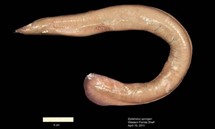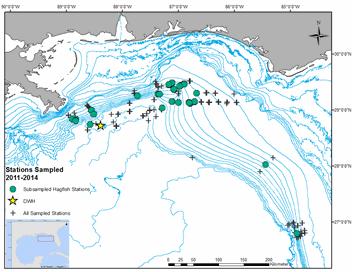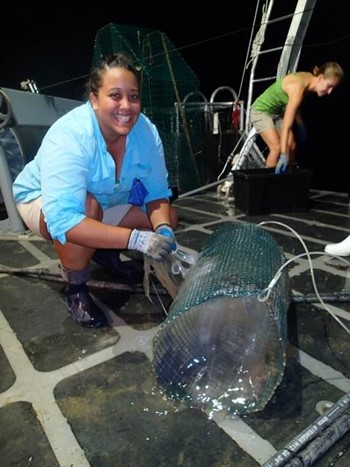Hagfish
Overview

Hagfishes (Myxinidae) represent the most basal and primitive "vertebrates" known, living or extinct. Despite their evolutionary longevity, and at least 70 extant species distributed in most world oceans, there is still a dearth of knowledge of the life histories and ecology of most species. Hagfishes are typically thought to occupy an ecological niche as scavengers. Their presence provides important ecosystem services like the removal of carrion falls and bycatch discards that would otherwise accumulate in the ocean floor and they also play a key role in the cycling of carbon and other nutrients.

Nonetheless, commercial interest for these fishes has dramatically increased in the past decades and they are now targeted for their flesh, skin and slime for the use of food, leather and pharmaceutical products. This increase in commercial interest combined with a lack of ecological knowledge needed to efficiently formulate management plans, is resulting in the overfishing of some populations.
In the GOM, from the West Florida Slope (WFS) to the Louisiana Slope (LAS), hagfish are common to abundant in specific bottom types and areas; however, little is known about their biology and their role in deep water ecosystems. Three species are found in the Gulf of America (GoAm) region (Eptatretus springeri), Eptatretus minor, Myxine mcmillanae) at different depth ranges. E. springeri is the most common and inhabits depths of 400-700 meters, M. mcmillanae is less common and has a broader depth distribution (500-1100 m) and E. minor is the least common and is found between 400 and 500 m (D. Grubbs personal communication). E. springeri and E. minor, are endemic to the GoAm while M. mcmillanae is also found in the Caribbean Sea. As with most other hagfish species, basic ecological and biological information from these three species is lacking. With this study we aim to obtain information on the role E. springeri, E. minor and M. mcmillanae play in GoAm deep-sea food web dynamics, nutrient cycling and energy transfer and how these aspects are influenced by spatial and temporal patterns and anthropogenic disturbances such as the Deep Water Horizon Oil Spill.
Feeding Ecology and Trophic Structure

The trophic structure and feeding ecology of the three species of hagfish from the GoAm has yet to be studied and consequently, their ecological importance in the GoAm deep sea ecosystem is unknown, particularly their roles in the deep sea trophic dynamic, substrate turnover, carbon cycling and energy flow from pelagic to benthic systems. We will study the feeding ecology and trophic structure of E.springeri, E. minor and M. mcmillanae using techniques based on molecular and elemental analyses. The study area of predation through the use of molecular analysis by amplification of prey DNA from stomach contents or feces is a rapidly growing field. The feeding ecology of the GoAm hagfishes will be examined using DNA based molecular diagnostic techniques to detect specific prey in collected stomach content and fecal samples. In comparison to traditional visual inspections of the stomach contents, molecular techniques can provide better insight into diet by allowing us to identify even highly digested prey.
The trophic structure of the GoAm hagfishes will be examined using stable isotope analysis of carbon, nitrogen and sulfur. Carbon and sulfur isotopes fractionate very little and between predator and prey and can be used to obtain information on the origin of resources ingested by hagfish and whether they derive their energy source from benthic or pelagic primary productivity or from chemoautotrophic productivity associated with Gulf Seep sites. Nitrogen isotopes are subject to larger fractionation and the nitrogen signatures of hagfishes will be used to assess their trophic position in the GoAm relative to other members of the deep-sea food web. The variation in temporal and spatial distributions of sampling sites within the GoAm will allow us to examine the influence of different environmental gradients in diet composition and potential inter and intraspecific shifts in hagfish feeding strategies.
Using a DNA based approach for prey identification in concert with SIA will allow us to accurately describe the trophic structure and feeding ecology of the three GoAm hagfish species.
Mercury Bioaccumulation
Directly linked to trophic structure and feeding behavior is the bioaccumulation of some heavy metals into animal tissue. One such metal is mercury (Hg), which is introduced to the open ocean by natural and anthropogenic sources. Once in the water column, Hg can remain as inorganic mercury (IHg), be reduced to a gaseous form and evaded back to the atmosphere or transformed by sulfur reducing bacteria into an organic and toxic form of Methyl-mercury (MeHg) The bulk of the research on Hg levels in marine biota has been performed on species commonly consumed by humans and on upper level predators like sharks and marine mammals because their trophic position at the top of marine food webs makes them suitable bioindicators of Hg bioaccumulation and bioconcentrations.

The high concentrations found in these organisms may pose a bigger risk for scavengers such as hagfish, who may feed solely on carrion falls and fisheries bycatch discards made of these top level predators. Base Hg levels of hagfishes of any species, as well as the influence of inter and intra specific variations in feeding strategies on hagfish tissue Hg concentrations are poorly studied. We will obtain MeHg and IHg concentrations from muscle tissue of all three species found in the GoAm and investigate how feeding strategies and trophic structure affect bioaccumulation and bioconcetration levels in these three species.
In the summer of 2010 the Deep Water Horizon (DWH) oil spill released large quantities of oil that eventually settled onto the Gulf of America sea floor. It is believed that the release of oil may have created better reducing conditions for sulfur reducing bacteria for the methylation of Hg. Hagfishes from the GoAm may have been particularly affected by this event because of their, their burrowing behavior and the potential ability of hagfishes to absorb nutrients through their skin and gills. Burrowing may have also caused resuspension and resurfacing of organic matter and Hg that was sequestered in anoxic sediments after the oil spill, introducing a higher Hg load into the GoAm deep-sea food web. I will investigate potential effects of the DWH oil spill on Hg concentrations of hagfish by comparing Hg levels of tissues from areas of minimal exposure to areas that were heavily exposed to oil from the DWH oil spill.
Knowledge of base levels of Hg from hagfish species could help determine safe consumption rates for humans and also shed light onto the consequences, if any, the DWH oil spill may have had on the Hg levels of the GoAm deep sea fauna.
Significance
Hagfish fulfill important ecosystem roles in most world oceans and the continued decline of stocks around the world is detrimental not only for hagfish species but also for the ecosystems in which they inhabit. This research could offer important information on their influence in deep sea food web dynamics and nutrient cycling in the GoAm. The toxicological findings of this research could provide information regarding safe consumption rates to the fishing industry, as well as to the consumers. Furthermore, these findings could offer insight onto biological and ecological strategies that may have contributed to the evolutionary success of these primitive species and concomitantly provide information that would be of great relevance for the creation and implementation of an ecosystem based fisheries management plan in the GoAm and as supportive information for the fisheries worldwide.

